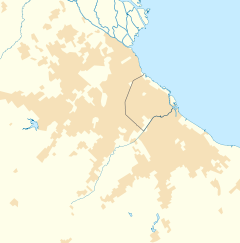Quinta de Olivos
| Quinta de Olivos | |
|---|---|

Main house
|
|
|
Location in Greater Buenos Aires
|
|
| General information | |
| Architectural style | Eclecticism (Neogothic and Baroque) |
| Town or city | Olivos, Buenos Aires |
| Country | Argentina |
| Coordinates | 34°30′54″S 58°28′59″W / 34.51500°S 58.48306°W |
| Construction started | 1854 |
| Client | Miguel de Azcuénaga |
| Technical details | |
| Size | 32 hectares (79 acres) (estate) |
| Design and construction | |
| Architect | Prilidiano Pueyrredón |
The Quinta de Olivos is an architectural landmark in the north side Buenos Aires suburb of Olivos and the official residence of the President of Argentina. It is one of the President's official residences.
Shortly after the 2nd foundation of Buenos Aires by Captain Juan de Garay in 1580 (the first one was in 1536 by Pedro de Mendoza ), among the first 400 land lots apportioned was that of a 180-hectare (450 acre) parcel 20 kilometers (13 mi) north of the city. The land, situated on a bluff overlooking the Río de la Plata, was awarded to Rodrigo de Ibarola, a lieutenant of Garay's. A prime section of the property was purchased in 1774 by Manuel de Basavilbaso, the Postmaster General of the Viceroyalty of the Río de la Plata. His daughter, Justa Rufina, married Miguel de Azcuénaga, a military officer who would later take part in the May Revolution of 1810 (prologue to the Argentine War of Independence). He also established one of the area's first apiaries on the grounds.
Azcuénaga inherited the land on the death of his wife in 1829, and their son, Miguel José, in turn inherited it in 1833. He converted the property into an equestrian estate, though the rise of Buenos Aires Province Governor and strongman Juan Manuel de Rosas led to his exile in Chile for a number of years. Azcuénaga ultimately returned and, in 1851, commissioned a graduate of the École Polytechnique, Prilidiano Pueyrredón, to design a manor house. Pueyrredón created an eclectic design centered on Neogothic and Baroque architecture, and upon its completion in 1854, Azcuénaga came to refer to the mansion as his "birdcage"; Pueyrredón was also a renowned painter, and created a portrait of his friend and client shortly after the mansion's completion.
...
Wikipedia

